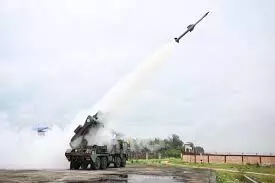India Successfully Tests Maiden Flight of Integrated Air Defence Weapon System (IADWS)
India’s DRDO successfully tests maiden flight of Integrated Air Defence Weapon System (IADWS), a multi-layered shield with QRSAM, VSHORADS & DEW.
DRDO successfully tests maiden flight of Integrated Air Defence Weapon System (IADWS) off the Odisha coast on August 23, 2025.

On August 23, 2025, the Defence Research and Development Organisation (DRDO) successfully carried out the first flight tests of the Integrated Air Defence Weapon System (IADWS), marking yet another milestone in Indian defence technology. Around 12:30 pm, the multi-layered system was tested off the coast of Odisha.
IADWS: What is it?
Three essential indigenous components are integrated into the IADWS, a sophisticated multi-layered air defence platform:
- QRSAM, or Quick Reaction Surface-to-Air Missile
- System of Very Short Range Air Defence (VSHORADS)
- High-power laser-based defence technology known as the Directed Energy Weapon (DEW)
- India's ability to combat a variety of aerial threats, such as enemy aircraft, missiles, and drones, is improved by this state-of-the-art combination.
Layered Defence Architecture with Proven Results
The effectiveness of India's multi-layered air defence has already been proven. The system's ability to successfully intercept hostile missiles and drones during the May 2025 conflict with Pakistan highlighted its importance in protecting vital infrastructure.
- Rajnath Singh congratulates DRDO
- The accomplishment was praised by Defence Minister Rajnath Singh, who described it as a significant advancement in bolstering India's aerial security.
- "I congratulate the industry, the military, and DRDO on the successful development of IADWS. He posted on social media, "This special flight test has demonstrated India's multi-layered air-defense capability and will strengthen area defence against enemy aerial threats."
- The successful test increases India's defence technology independence and fortifies its readiness to counter changing regional threats.

